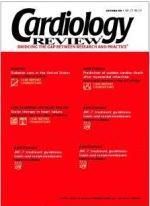Publication
Article
Cardiology Review® Online
Drug or device in nonischemic cardiomyopathy?
The implantable cardioverter-defi-brillator (ICD) represents a major advance in the prevention of sudden cardiac death in patients at highest risk. The indications for ICD implantation have been recently expanded to include patients with reduced ejection fractions because of previous myocardial infarction.
This recommendation was based on the results of the Multicenter Automatic Defibrillator Implantation Trial-II (MADIT-II).1 Despite the growing body of evidence supporting the superiority of ICD therapy
in patients with ischemic heart disease, there are few studies examining the use of ICDs in patients with nonischemic cardiomyopathy.
In the Amiodarone Versus Implantable Cardioverter-Defibrillator Trial (AMIOVIRT), reported by Wijetunga and Strickberger (page 18), patients with established non-ischemic cardiomyopathy were
randomized to either ICD or amio-
darone therapy. There was no significant difference in mortality between the two groups, and the
trial was stopped.
This is similar to the findings of the Cardiomyopathy Trial (CAT), in which 104 patients with recently diagnosed nonischemic cardiomyopathy were randomized to ICD versus standard therapy.2 There was no survival difference between the groups. Two-, 4-, and 6-year survival rates in this trial were 92%, 86%, and 73%, respectively, in the ICD group versus 93%, 80%, and 68% in the control group.
In AMIOVIRT, the 1- and 3-year survival rates for ICD patients were 96% and 88%, respectively, versus 90% and 87% in patients treated with amiodarone. In contrast, control patients with ischemic cardiomyopathy in the MADIT-II trial had a 20-month survival rate of 80.2%. ICD therapy improved this survival rate to 85.8%, which is still lower than survival rates in patients with nonischemic cardiomyopathy.
The lack of efficacy of either ICD or amiodarone appears to be related to the surprisingly low mortality rates reported in these patients. AMIOVIRT randomized patients with New York Heart Association (NYHA) functional class I to III symptoms of congestive heart failure (CHF), and CAT randomized those with NYHA functional class II and III CHF.
In AMIOVIRT, 25% of the patients were classified as having NYHA functional class III heart failure, and in CAT, 34.6% were classified in functional class III. It is unknown if the results would have been different for patients with functional class III only, or for subgroups with an elevated risk of sudden death.
Preliminary results of the Defibrillators in Nonischemic Cardiomyopathy Treatment Evaluation (DEFINITE) trial were presented at this past American Heart Association meeting.3 This trial randomized 458 patients with nonischemic cardiomyopathy to either medical therapy or ICD therapy. This trial showed no significant improvement in overall mortality despite a reduction in arrhythmic deaths. In this trial, 79% of patients had NYHA functional class I or II heart failure.
Conclusion
Unfortunately, we cannot accurately define the risk for sudden cardiac death in patients with nonischemic cardiomyopathy. Unlike the patients with ischemic cardiomyopathy, electrophysiologic testing does not predict outcome. Perhaps newer tests, such as T-wave alternans, will be helpful. Until we are able to define a subgroup of patients with nonischemic cardiomyopathy and elevated risk of sudden death, the role of the ICD in nonischemic cardiomyopathy will be relegated to secondary prevention. We look forward to the results of larger prospective trials in this difficult-to-treat population of patients.
